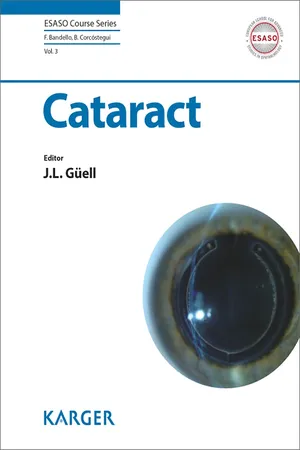
This is a test
- 153 pages
- English
- ePUB (mobile friendly)
- Available on iOS & Android
eBook - ePub
Cataract
Book details
Book preview
Table of contents
Citations
About This Book
In the 'ESASO Course Series', the essentials of the courses of the European School for Advanced Studies in Ophthalmology (ESASO) are made available in print.
Frequently asked questions
At the moment all of our mobile-responsive ePub books are available to download via the app. Most of our PDFs are also available to download and we're working on making the final remaining ones downloadable now. Learn more here.
Both plans give you full access to the library and all of Perlego’s features. The only differences are the price and subscription period: With the annual plan you’ll save around 30% compared to 12 months on the monthly plan.
We are an online textbook subscription service, where you can get access to an entire online library for less than the price of a single book per month. With over 1 million books across 1000+ topics, we’ve got you covered! Learn more here.
Look out for the read-aloud symbol on your next book to see if you can listen to it. The read-aloud tool reads text aloud for you, highlighting the text as it is being read. You can pause it, speed it up and slow it down. Learn more here.
Yes, you can access Cataract by J. L. Güell in PDF and/or ePUB format, as well as other popular books in Medicine & Opthalmology & Optometry. We have over one million books available in our catalogue for you to explore.
Information
Topic
MedicineSubtopic
Opthalmology & OptometryGüell JL (ed): Cataract. ESASO Course Series. Basel, Karger, 2013, vol 3, pp 1-25
DOI: 10.1159/000350899
DOI: 10.1159/000350899
______________________
Cataract Surgery: An Update on Basics and Surgical Tips
Khiun Tjia
Isala Clinics, Zwolle, The Netherlands
______________________
Abstract
In this chapter, the basics of fluidics and ultrasound action are rehearsed, which are fundamental to better understand the challenges and solutions of all kinds of non-routine phacoemulsification cases. Specific properties of torsional ultrasound are explained, which give a better insight of the advantages of this ultrasound modality. Practical tips and tricks are provided to improve one's hydrodissection skills, soft lens removal and the pitfalls of posterior polar cataract. Hard cataracts and chop techniques are thoroughly discussed as well as small pupil management. Challenging situations such as mature and hypermature cataracts, floppy iris syndrome, weak zonules and last but not least posterior capsule rupture management are explained.
Copyright © 2013 S. Karger AG, Basel
This chapter is intended to refresh the study material provided at the ESASO cataract module by the author, Khiun Tjia, a cataract surgery specialist. This reading material is not suitable as a stand-alone educational tool, but should be combined with the video clips presented during the course.
The information in this chapter reflects my opinion of cataract surgery techniques. It only covers the topics discussed during the one-day course by Dr. Tjia.
There are many textbooks on cataract surgery, which can help the reader understand cataract surgery technology and techniques in depth.
Basics Fluidics and Ultrasound
The key point in fluid dynamics during pha-coemulsification surgery is that the fluid going into the eye should always exceed the amount of fluid going out of the eye at all times. If not, the anterior chamber shallows and the posterior capsule will move upward and potentially come into contact with the phacotip, which can result in a posterior capsule rupture.
The inflow is determined by the irrigation flow only; the hydrostatic pressure of the water column in the irrigation line until the level of the drip chamber underneath the infusion bottle is expressed in centimeters (bottle height). The resistance in the entire irrigation line including the narrow space between the sleeve and the phacotip determines the final irrigation flow: irrigation pressure/irrigation resistance.
When the phacotip is completely occluded, and no leak flow occurs through any of the incisions, one must be aware of the actual intraocular pressure. The entire fluid (water) column of the irrigation line presses in the eye. For instance, a bottle height of 75 cm H2O translates into 750 mm H2O, and divided by the relative weight of mercury of 13.6 results in an intraocular pressure of approximately 55 mm Hg. Extreme bottle heights of 150 cm are used by some surgeons, which results in 110 mm Hg pressure when the tip is occluded (fig. 1)! One should be extremely cautious about utilizing bottle heights exceeding 100 cm which causes pressure spikes of more than 73 mm Hg.
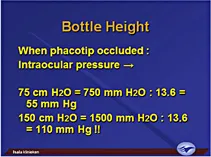
Fig. 1. Bottle height.
Irrigation pressure is either passive with a bottle hanging above the level of the eye as described above, or is active by a pressurized system, which is not discussed in this chapter. With an active pressure system, the required pressure can be set on the machine in mm Hg.
Before discussing outflow, we have to understand the different pump systems of existing pha-comachines: peristaltic pump systems and Venturi pump systems.
Peristaltic pumps consist of rollers which push fluid through a flexible aspiration tubing. The aspiration flow increases with the increasing speed of the rollers (fig. 2).
Venturi pumps create a vacuum in a rigid cassette by forcing gas through a pipe connected to the cassette. With more gas force blown through the pipe, higher vacuum is created in the cassette, which in turn attracts more fluid from the aspiration line (fig. 3).
The main difference between the two systems is that in Venturi pump systems, the vacuum and aspiration flow are directly linked to each other. One cannot set a high vacuum and a low flow. With a peristaltic pump, vacuum and aspiration flow can be controlled independently (fig. 4).
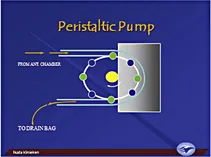
Fig. 2. Peristaltic pump.
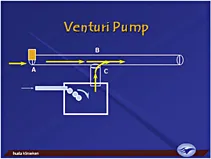
Fig. 3. Venturi pump.
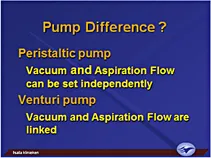
Fig. 4. Pump difference.
Outflow of the eye during phacosurgery is more complex and consists of the following: aspiration flow, leak flow and surge flow.
As a cataract surgery specialist, I have a very specific preference for peristaltic pump systems. The ability to control vacuum and flow separately is essential for managing challenging cases for me. I am discussing fluidic dynamics in the peristaltic machine in the next paragraph.
Aspiration Flow
The speed of rollers in the cassette determines the aspiration flow and can be set on the machine in ml/min. Aspiration flow can only occur when the tip is not fully obstructed. When the phacotip is fully occluded, there is no flow. The actual flow passing through the aspiration line is dependent on the force of the phacopump pulling the fluid, and the total resistance in the aspiration line. Pump capacities and aspiration line lumen sizes vary among the available phacomachines. The preset values displayed on the machines do not necessarily occur in real time. A good example is that the aspiration flow at the same machine setting of e.g. 50 ml/min can be close to that value with a large bore phacotip of 0.7 mm and a normally large lumen aspiration tubing. In contrast, the preset value of 50 ml/min will not be reached through the very small 0...
Table of contents
- Cover Page
- Front Matter
- Cataract Surgery: An Update on Basics and Surgical Tips
- Multifocal and Accommodative Intraocular Lenses
- An Introduction to Intraocular Lenses: Material, Optics, Haptics, Design and Aberration
- Femtolaser Cataract Surgery
- Laser-Assisted Cataract Surgery with LenSx
- Phakic Intraocular Lenses
- Phakic Intraocular Lenses in Keratoconus
- Laser Corneal Refractive Surgery: An Update
- Intracorneal Refractive Surgery: Lenses and Ring Segments
- Subject Index